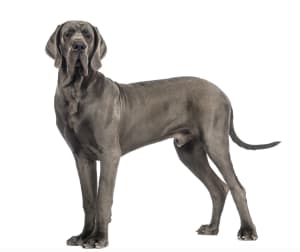Great Dane
Great Danes are large lovable dogs that need exercise and space. Many Great Danes are "leaners"-- they lean against their people to be closer to them, seemingly oblivious to their size!
Fun Fact
A Great Dane called Zeus is the world record holder for the tallest dog, measuring 44in from paw to shoulder.
-
Great Danes at a glance
Because of their beauty and gentle nature, more and more people are discovering the dog breed known as the Great Dane. Are you thinking of bringing a Great Dane home? There’s so much to learn about this gentle giant, and we’re here to help. We’ll explore this breed’s physical characteristics, nutritional needs, playtime tips, and much more. At the bottom of this guide, look for our comprehensive list of all the health conditions we test for here at Embark. The sweet faces of these dogs and their patient and dependable temperament are why Great Danes make for such a popular addition to families and are considered to be very affectionate with children. The Great Dane is among the largest dog breeds — only the Irish Wolfhound is taller. -
About Great Danes
The Great Dane was originally bred to hunt wild boar, and was developed from Mastiff-type dogs. Nowadays, Great Danes are known for their protective nature and their unwavering love for their humans. Their massive and intimidating size leads many to be deceived, as they are friendly and sensitive people-pleasers that might sprawl across the entire couch, desperate for your cuddles. Safe to say that bringing one of these courageous and loyal dogs into your home will allow for restful nights knowing that your Great Dane is on the lookout. The Great Dane is nicknamed the “Apollo of Dogs,” as they are majestic and regal. According to the AKC, the first known written description of a dog closely resembles the Great Dane, found in Chinese Literature that dates back to as early as 1121 BC. -
Physical characteristics
Great Danes are one of the largest working breeds and often tower over their people when standing on their hind legs. The average Great Dane ranges from 110 to 175 pounds. Though they can be as tall as 32 inches at the shoulder, they remain sturdy and well-balanced, according to the AKC. Being muscular and bearing a smooth coat, their appearance is often majestic and grand. PetMD states that the coat of a Great Dane is short, shiny, and can come in various colors and patterns, including brindle, black, harlequin, mantle, and more. 
-
Bringing your new Great Dane home
Your house might look a little smaller when this giant breed is settled in! Bringing home a new family member can be overwhelming, as a lot is changing for both you and your furry friend. It’s important for your Great Dane to be socialized early and be exposed to as many friends as possible, both dog and human. Great Danes are eager to please their people and through positive reinforcement methods, these goofballs will be perfectly well-mannered in no time. Before adopting a Great Dane, make sure to understand the commitment of owning such a large dog. -
Nutrition
Want to make your Great Dane’s stomach happy and healthy? Feed them dog food that is age-appropriate and high-quality. While we know that your dog is a part of the family, avoid giving them human food from the family dinner table. The biggest health risk for this breed is bloat, otherwise known as gastric dilatation-volvulus, The American College of Veterinary Surgeons reported. While the causes are not fully understood, feeding your Great Dane several small meals each day could help to decrease the chances of bloat. The best way to come up with the proper meal plan for your dog is to talk to your veterinarian. -
Playtime
With their tremendous size, it's advisable to teach Great Danes good manners and get them to attend puppy training classes. This breed requires exercise every day and are avid lovers of physical activities. Your Great Dane will likely make for an excellent jogging or hiking companion and is a great choice for humans who enjoy the outdoors. The AKC recommends waiting until your Great Dane is at least 2 years old before taking them on vigorous adventures, as a way to avoid injury to growing joints. Avoiding physical activity around mealtime is reportedly another way to lower the chances of bloat. 
-
Grooming
With the love of a furry companion comes drool, some shedding, and more drool. According to The Daily Puppy, brushing your Great Dane every day with a bristle-body brush will keep their coat shiny as ever! Great Danes don’t shed a lot, but there might be some drool involved. -
Health and aging in Great Danes
As your dog gets older, it’s important to schedule regular visits with your veterinarian. While their massive size makes for the best hugs, it also causes Great Danes to be prone to bone and joint issues as they age. Because of their size, they also have a relatively short life span of around eight years old. That means they may take up a huge space in your heart, but for only a short amount of time. 
An Embark dog DNA test looks at the following health conditions in Great Danes:
If you haven’t tested your dog yet, order your Embark dog DNA test today! -
Health Conditions
Learn about your dog's genetic breed ancestry with Embark
Dog owners
Breed identification, health and trait insights, personalized care recommendations, and the world’s first canine relative finder—all in one leading dog DNA test.
Learn about the report for dog ownersShop the test
Breeding programs
Embark’s test for breeding programs is one comprehensive DNA test designed with your needs in mind.
Learn about the report for breedersShop the test








